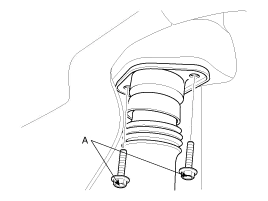Hyundai Genesis (DH): Rear Suspension System / Rear Shock Absorber Repair procedures
Hyundai Genesis (DH) 2013-2016 Service Manual / Suspension System / Rear Suspension System / Rear Shock Absorber Repair procedures
| Removal |
| 1. |
Loosen the wheel nuts slightly. Raise the vehicle, and make sure it is securely supported. |
| 2. |
Remove the front wheel and tire (A) from the rear hub.
|
| 3. |
Support the lower portion of the rear axle with a jack securely. |
| 4. |
Loosen the bolt & nut and then separate the rear shock absorber.
|
| 5. |
Disconnect solenoid ESC & wheel speed sensor connector
and then remove the wheel speed sensor bracket by loosening the bolt.
|
| 6. |
Loosen the bracket bolt (A) to disconnect the rear shock absorber from the wheel housing panel.
|
| 7. |
Installation is in the reverse order of removal. |
| 8. |
Check the alignment.
(Refer to Tires/Wheels - "Alignment")
|





